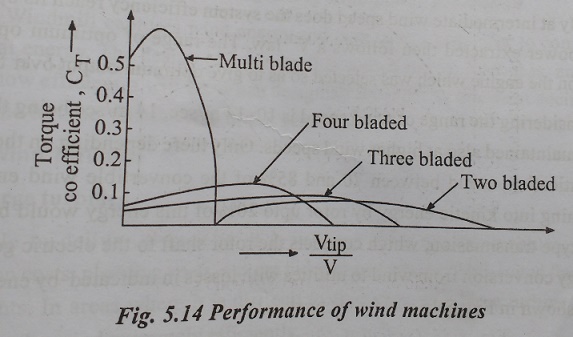Chapter: Electric Energy Generation and Utilisation and Conservation : Wind Energy
Performance of Wind Machines

PERFORMANCE OF
WIND MACHINES
WECS
efficiency is of interest to both aerogenerator designers and system engineers.
As WECS is a capital intensive technology, it is desirable for the overall wind
electric plant to have the highest efficiency possible, thus optimally
utilizing capital resources and minimizing the busbar electric energy cost.
The
overall conversion efficiency, µoof an aerogenerator of the general
type is

Above
equation shows an application of cascaded energy conversion, from which overall
efficiency will be strongly determined by the lowest efficiency converter in
the cascade. For the aerogenerator this is the aeroturbine; the efficiency of
the remaining three elements can be made quite high but less than 100 percent.
It is now evident why so much emphasis is placed on the efficiency of the
aeroturbine in wind literature.
Consider
an arbitrary aeroturbine (Here Aero turbine is not equal to aerogenerator) of
cross-sectional area ‘A’ driven by the wind. Its efficiency would be:

Thus
the coefficient of performance of an aeroturbine is the fraction of power in
the wind through the swept area which is converted into useful mechanical shaft
power. The coefficient of performance is widely utilized throughout the recent
wind research. We have seen that Cp for horizontal axis wind machine
has theoretical maximum value = 0.593.
This
theoretical efficiency limitation on a wind energy conversion system is loosely
analogical similar to the thermodynamic carnot efficiency limitation on a
conventional thermal power plant.
We
know that the convertible power of energy is proportional to the cube of the
wind speed. Thus if the wind speed decreases by 20%, the power output is
reduced by almost 50%. The wind speed may very considerable from day to day and
from season to season. The efficiency of a wind generator depends on the design
of an wind rotor and rotational speed, expressed as the ratio of blade tip
speed to wind speed i.e., VT/V (is called as TSR – Tip Speed Ratio),
if n is the rotation frequency, ie., rotation per second, if a rotor diameter D
meters, the tip speed is πnD m/sec.
The
dependence of the power coefficient on the tip speed ratio (TSR)
for some common rotor types is indicated in Fig. 5.13. It is seen that the
two-bladed propeller type of rotor can attain a much higher power coefficient
(i.e., it is more efficient) than the American multi-blade wind mill and the
classical Dutch four-bladed windmill. In practice two-bladed propeller
(horizontal axis) rotor are ound to attain a maximum power coefficient of 0.40
to 0.45 at a tip speed ratio in the range a roughly 6 to 10

Golding
has derived the expression for aeroturbine efficiency as,

Clearly
If there were no drag, i.e., K=0, then efficiency would be unity (μA=1).
In actuality K can be made very small, depending on the airfoil choosen and the
angle of attack. Also above equation tells us the efficiency would be low if VT/V
were very large or again If it were small. One suspicions that there exists an
optimum ratio of VT/V (i.e., TSR).
If
one assembles models of various types of aeroturbine blades and puts them in a
wind tunnel and runs carefully controlled experiments of their efficiencies as
function of their TSR’S, then one obtains a family of curves similar to that
shown in Fig.5.14.
The
various types of windmills performance characteristics with respect to TSR and
torque coefficient are shown in Fig. 5.14.

Only
at intermediate wind speed does the system efficiency reach its optimum and the
power extracted then follows a V3 law. The range of optimum
operation depends on the engine which was selected so as to give optimum output
over the year.
Considering
the range of wind speed is 10-14m/sec, 14m/sec being the rated velocity
maintained also at higher wind speeds. Only there depending on the degree of
sophistication, could between 70 and 85% of the convertible wind energy by the
gear type transmission, which connects the rotor shaft to the electric
generator. The energy conversion from wind to utilities with losses in
indicated by energy flow diagram shown in Fig. 5.15.
Related Topics